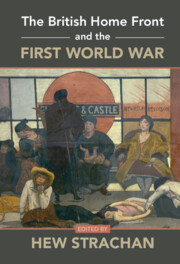Book contents
- The British Home Front and the First World War
- The British Home Front and the First World War
- Copyright page
- Contents
- Figures
- Tables and Charts
- Contributors
- Acknowledgements
- A Note on the Illustrations
- Introduction
- 1 The United Kingdom in 1914
- Part I Government
- Part II Resources
- 7 Iron and Steel
- 8 Timber
- 9 Fishing
- 10 Agriculture
- 11 Coal
- 12 War Finance
- Part III People
- Part IV Production
- Part V Social Impacts
- Conclusion
- Index
8 - Timber
from Part II - Resources
Published online by Cambridge University Press: 23 February 2023
- The British Home Front and the First World War
- The British Home Front and the First World War
- Copyright page
- Contents
- Figures
- Tables and Charts
- Contributors
- Acknowledgements
- A Note on the Illustrations
- Introduction
- 1 The United Kingdom in 1914
- Part I Government
- Part II Resources
- 7 Iron and Steel
- 8 Timber
- 9 Fishing
- 10 Agriculture
- 11 Coal
- 12 War Finance
- Part III People
- Part IV Production
- Part V Social Impacts
- Conclusion
- Index
Summary
Wood and timber were essential materials in maintaining the British war effort. Trench and tunnel revetments held up the western front, pit-props meant the mining industries could continue to supply munitions factories and railways, and the construction of camps housing new armies or migrant workers required massive amounts of timber. Although the First World War is seen as a pivotal event in the road to modernity, the list of vital uses for this ancient material is long. The woodlands of pre-war Britain were poorly managed for timber production, the nation relying very heavily on bulky imports. Improved self-sufficiency was therefore especially important as available shipping space declined as the war progressed. Although from mid-1916 a great deal of timber utilised on the western front was obtained from French forests by Canadian lumbermen, the woodlands, forestry profession and branches in the timber trade of the United Kingdom had to be mobilised and controlled to meet demand. The fact that stocks were eventually established, both in Britain and on the continent, and that shortages were never crippling to the war effort, illustrate how well these measures worked.1
- Type
- Chapter
- Information
- The British Home Front and the First World War , pp. 153 - 182Publisher: Cambridge University PressPrint publication year: 2023



